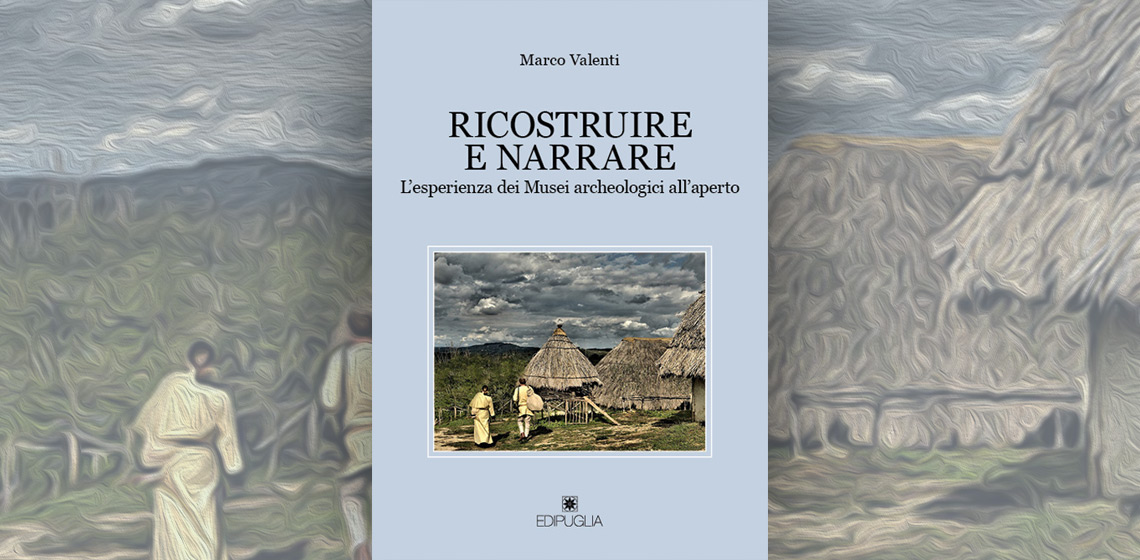The content is published under a Creative Commons Attribution Non-Commercial 4.0 License.
Unreviewed Mixed Matters Article:
Book Review: Ricostruire e Narrare. L’esperienza dei Musei archeologici all’aperto (Reconstructing and storytelling. The experience of archaeological open-air Museums) by M. Valenti

This book is particularly welcomed within the scarce Italian literature on the topic of archaeological open-air museums. The lack of debate and accurate information on this type of museums in Italy, drove the author to put together this volume, seven years after the publication of Dr Paardekooper’s magistral “The Value of an Archaeological Open-Air Museum in its use” in 2012, often referred in this book.
The author immediately points out that there is a distorted idea about Archaeological Open-Air Museums (AOAMs) in Italy, often perceived as pure “Disneyfication” of cultural heritage. This type of venue is not considered as a proper museum, more of a funfair pursuing, mere engagement with consumerist goals, sometimes giving more space to unqualified re-enactors than to experimental archaeology. However, Valenti suggests that sometimes Italian AOAMs are themselves the primary cause of these critics, offering a low-quality level of contents and suggesting unplausible interpretations of the past.
The author highlights the history of open-air museum since the early “skansen”, an essential step before the development of the AOAMs. He treats different museums dividing them into main geo-chronological categories: late 19th century Scandinavia and Germany, the successful examples from North America, moving then to Europe and USA in the second post-war period.
The second chapter has been dedicated to the definition and description of the AOAMs, crediting the work of EXARC which, since its constitution, suggested a series of considerations in regards of the very nature of this type of museums. The author states since the beginning of the chapter that he will often quote Paardekooper’s work on European AOAMs, in the attempt of unlocking his valuable research to the Italian public.
Once again, the author prefers to examine the subject in chronological stages, starting from the Portuguese example of the reconstructions built on the site of Citânia de Briteiros, highlighting that the Second World War suddenly arrested the realization of new AOAMs projects. At this point the author reports a rich catalogue, highlighting some of the most famous AOAMs such as Lejre Centre (Denmark), Weald & Downland Living Museum (UK), Museum Village Düppel (Germany), Archeon (Netherlands), and dedicating specific paragraphs to a few case studies such as Samara (France), Hedeby-Haithabu (Germany) and West Stow (UK). Although the book provides the Italian reader with an unprecedented amount of contents on the topic, inevitably the information reported by the author often mirrors quite pedantically the text found on the museums’ websites, giving away a mainly virtual research.
Before examining the multivariate environment of Italian AOAM, the author dedicates a chapter to the concept of “time travel” and another to living history. The former describes, sometimes not without a certain “clumsiness”, how the practice of “time-travel” very common in the AOAMs, can be found applied in other contexts of our pop-culture such as video games, tv series and “colossal” movies. Once the author goes back to the practice of time-travel in different AOAMs, he always articulates his views and opinions on the cases highlighted.
I personally found the chapter dedicated to living history very interesting and I believe that it effectively helps the reader to appreciate the essential role that living history operators play in the success of this type of museum.
The last two chapters are dedicated to the story of AOAMs in Italy since its very beginning with the experience at Parco del Valentino, in Turin, which is suggested by the author as the first case for this type of museum in the Peninsula. The author managed to register more than 40 contexts which, at various levels, could be assigned to the AOAM phenomenon, dividing them in: single reconstructions, both in public areas or within archaeological parks; archaeological open-air museums; habitat-reconstructions inspired by specific archaeological contexts, aimed to foster a time-travel experience; and thematic parks aimed to a more “disneyfied” kind of public engagement. The author noticed a sudden development of these multivariate experiences since 2000 with some virtuous examples of AOAM based on serious and archaeologically accurate data, such as Archeoparc Valsenales, the Archaeological Park and Open-Air Museum of Terramara Montale or the Archeodromo of Poggibonsi, under his own direction.
In his conclusions, the author criticises the lack of a national network for AOAMs to foster dialogue and confrontation, sharing experience between the operators active in this type of museum. He exposes the issue of inadequate recognition of living history interpreters and reenactors by the Italian academia and wishes for an increased collaboration between the two groups, not only towards general public engagement, but also for educative purposes.
The book closes on some considerations upon a law that the Italian government promoted in 2016 towards the recognition of the importance of living history, the associations dedicated to it and reenactment events, allocating funding for € 2.000.000,00.
This book certainly represents an important contribution to the Italian literature available on this topic, providing the reader with a large amount of historical information on the birth and development of AOAMs, but also valuable considerations on time-travel, living history and their interesting coexistence within this type of museums. The author, who is directly involved in the field, directing an archaeological open-air museum which is in constant expansion, holds very strong opinions and is not afraid of sharing them, sometimes compromising the overall communication of the topic he treats.
Book information:
Valenti, M. 2019, Ricostruire e Narrare. L’esperienza dei Musei archeologici all’aperto, Bari: Edipuglia, 327 pp.
ISBN: 9780-88-7228-891-7; ISSN: 2532-5868; Cover Price: € 16,00
Keywords
Country
- Italy

